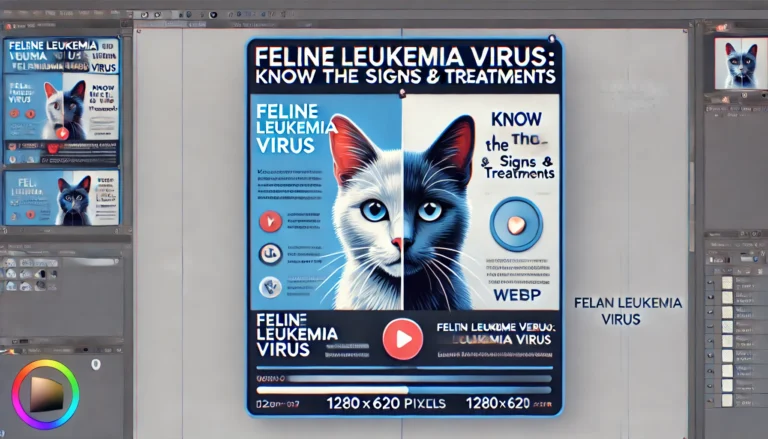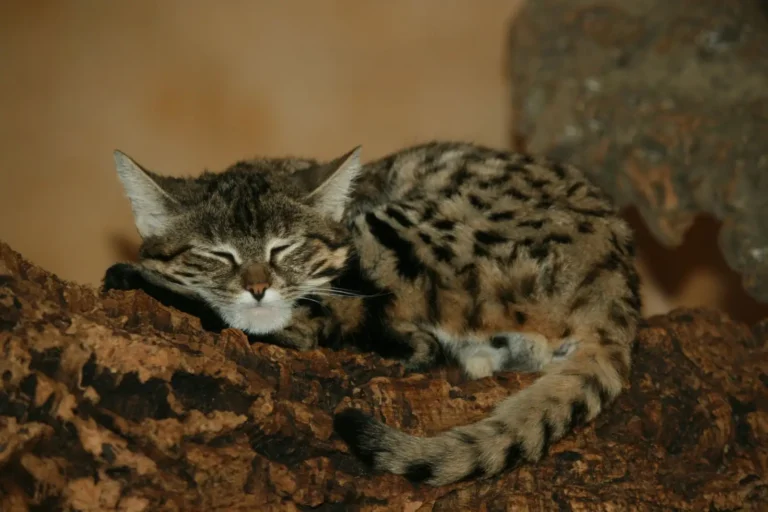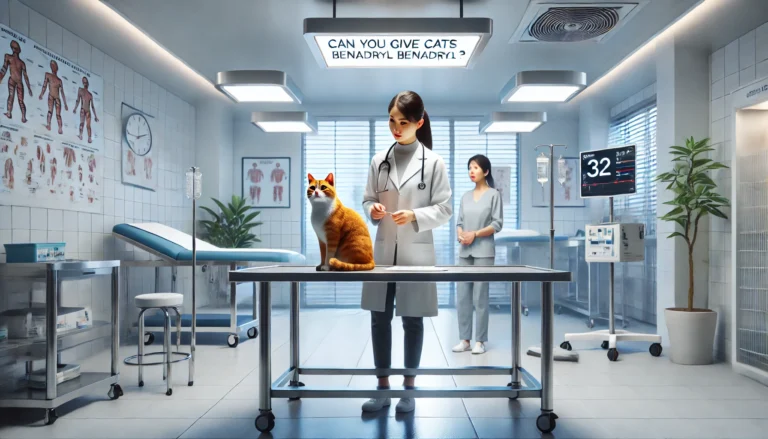10 Cat Anxiety Medications
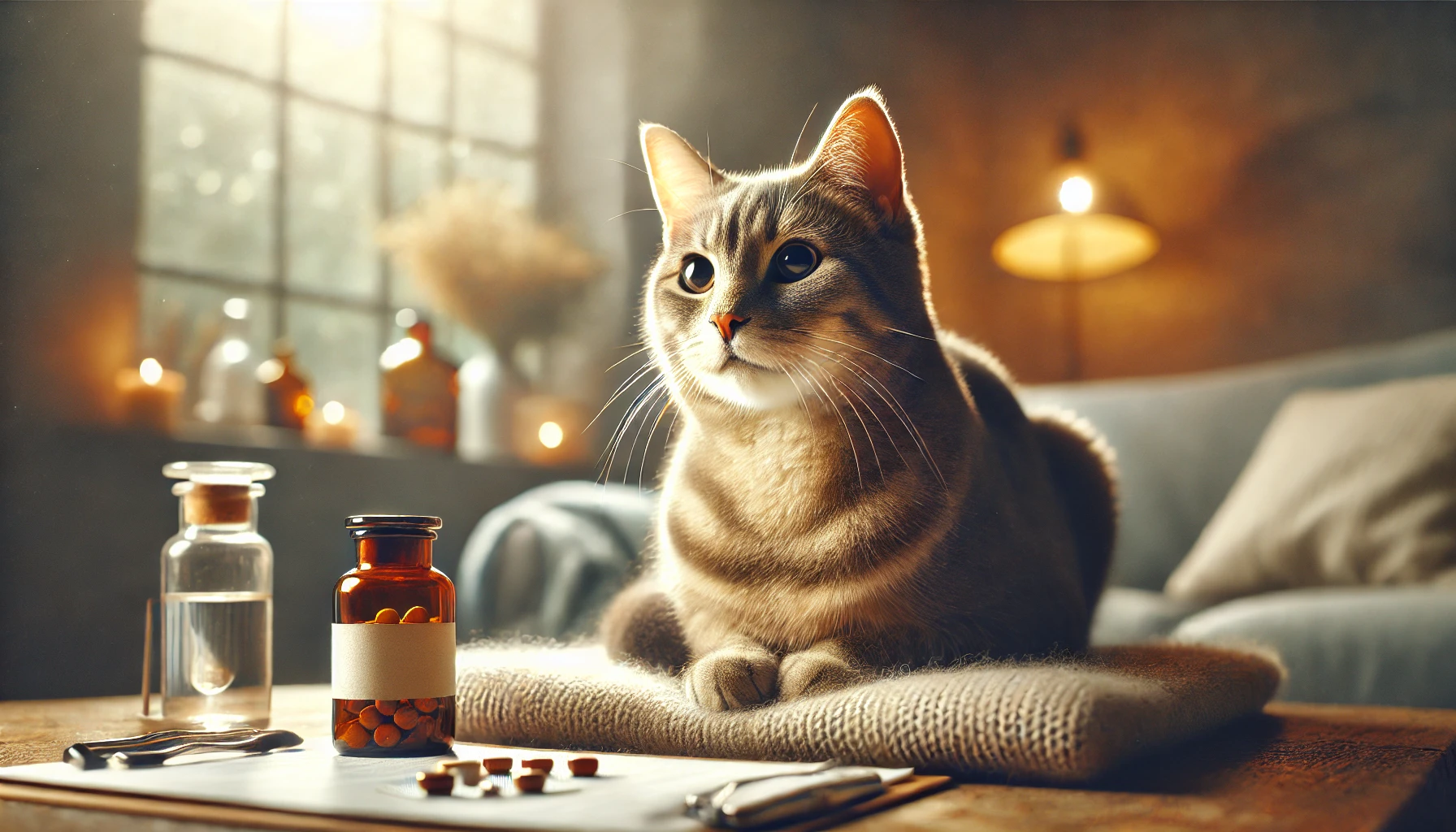
Cat Anxiety Medications:Anxiety is a common issue in cats, affecting their well-being and behavior. Whether triggered by environmental changes, separation anxiety, or certain health conditions, anxiety can lead to destructive behaviors and health problems if not properly addressed. Fortunately, there are several vet-approved medications available to help manage feline anxiety. This article will explore 10 different medications for cat anxiety, their uses, dosages, potential side effects, and other essential details.
Understanding Cat Anxiety Medications: Causes and Symptoms
Before diving into the specific medications, it’s important to understand the underlying causes of Cat anxiety medications and how it manifests. Feline anxiety can stem from a variety of sources, including:
- Environmental Changes: Moving to a new home, introducing new pets, or changes in routine can trigger anxiety in cats.
- Health Issues: Chronic pain or underlying illnesses can causeCat anxiety medications or worsen existing conditions.
- Separation Anxiety: Cats that form strong bonds with their owners may experience anxiety when left alone for extended periods.
- Loud Noises and Stressful Events: Thunderstorms, fireworks, or other loud noises can cause fear and anxiety.
Common symptoms of anxiety in cats include excessive grooming, aggression, hiding, urinating outside the litter box, and a loss of appetite.
1. Fluoxetine (Prozac)
Fluoxetine, commonly known by its brand name Prozac, is a selective serotonin reuptake inhibitor (SSRI) that’s commonly prescribed to cats suffering from anxiety. It works by increasing serotonin levels in the brain, helping to regulate mood and reduce anxiety.
Uses of Fluoxetine
Fluoxetine is typically prescribed for cats with:
- Separation anxiety
- Generalized anxiety
- Aggression
- Compulsive behaviors (such as excessive grooming or self-mutilation)
Dosage and Administration
The usual dosage for cats is between 0.5 to 1 mg per kilogram of body weight, administered once daily. It can take several weeks for noticeable improvements in behavior, so patience is key.
Side Effects
Fluoxetine is generally safe when prescribed by a vet, but some cats may experience mild side effects, including:
- Loss of appetite
- Lethargy
- Gastrointestinal issues (vomiting or diarrhea)
- Increased restlessness
2. Trazodone
Trazodone is an antidepressant that is commonly used as an anti-anxiety medication for cats. It belongs to the serotonin antagonist and reuptake inhibitor (SARI) class of drugs and is frequently used to manage short-term anxiety, such as that caused by travel or veterinary visits.
Uses of Trazodone
Trazodone is often prescribed for:
- Short-term anxiety (such as during travel or vet visits)
- Generalized anxiety
- Noise phobias (e.g., thunderstorms, fireworks)
Dosage and Administration
The recommended dosage is usually 1.5 to 3 mg per pound of body weight, given 1-2 hours before a stressful event. This medication works quickly, often providing relief within an hour.
Side Effects
Common side effects of trazodone in cats can include:
- Sedation
- Lethargy
- Gastrointestinal upset (vomiting or diarrhea)
- Increased appetite
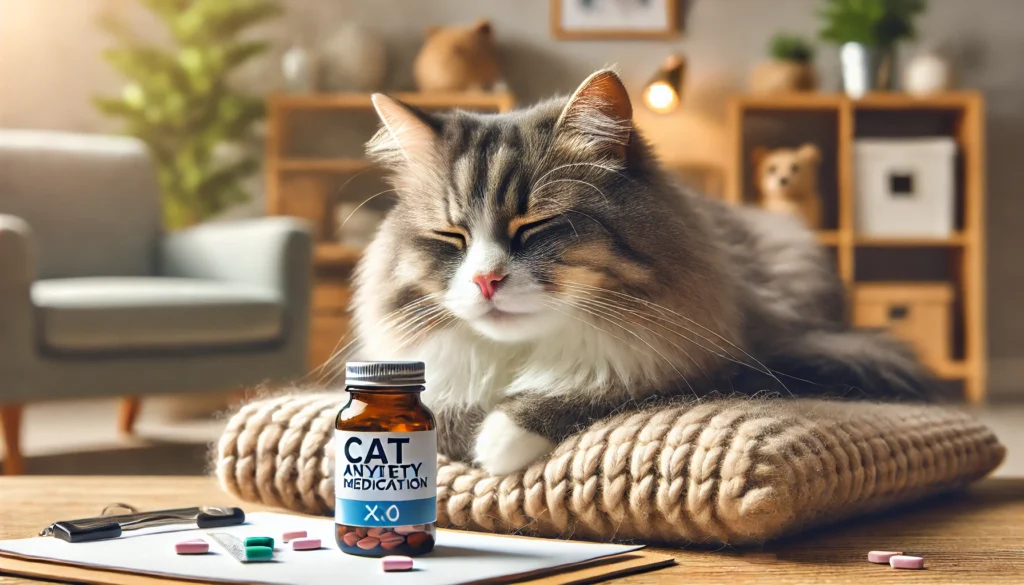
3. Alprazolam (Xanax)
Alprazolam, better known by its brand name Xanax, is a benzodiazepine that is used to treat anxiety in cats, particularly anxiety caused by stressful events such as fireworks or travel.
Uses of Alprazolam
Alprazolam is commonly used for:
- Situational anxiety (e.g., vet visits, travel)
- Noise phobias (loud sounds, thunderstorms)
- Short-term anxiety management
Dosage and Administration
The dosage for cats typically ranges from 0.01 to 0.05 mg per pound of body weight, taken 1-2 hours before the stressful event. The medication’s effects are usually noticeable within 30 minutes.
Side Effects
Possible side effects include:
- Sedation
- Disorientation or ataxia (lack of coordination)
- Drooling
- Mild gastrointestinal upset
4. Clomipramine (Clomicalm)
Clomipramine is a tricyclic antidepressant (TCA) that is primarily used to treat separation anxiety and compulsive behaviors in cats. It works by blocking the reuptake of serotonin and norepinephrine, thus increasing the availability of these neurotransmitters in the brain.
Uses of Clomipramine
Clomipramine is often prescribed for:
- Separation anxiety
- Compulsive behaviors (e.g., excessive grooming, scratching)
- Generalized anxiety
Dosage and Administration
The typical dosage for cats is around 0.5 to 2 mg per pound of body weight, given once daily. It may take several weeks for noticeable improvements in behavior.
Side Effects
Some cats may experience side effects, including:
- Drowsiness
- Loss of appetite
- Gastrointestinal issues
- Lethargy
5. Amitriptyline
Amitriptyline is another tricyclic antidepressant (TCA) that is commonly used to treat feline anxiety. It is particularly effective for managing chronic anxiety and certain behavioral issues.
Uses of Amitriptyline
Amitriptyline is often used for:
- Chronic anxiety (e.g., separation anxiety)
- Fear-based behaviors
- Compulsive behaviors
Dosage and Administration
A typical dosage of amitriptyline for cats is between 0.5 to 2 mg per pound of body weight, administered once or twice daily. It may take a few weeks to see results.
Side Effects
Common side effects can include:
- Sedation
- Dry mouth
- Lethargy
- Urinary retention
6. Buspirone (Buspar)
Buspirone is a medication that is often used to treat generalized anxiety and fear in cats. It is a serotonin receptor agonist, which works by increasing serotonin activity in the brain to promote calmness.
Uses of Buspirone
Buspirone is commonly used for:
- Generalized anxiety
- Fear-based aggression
- Situational anxiety (e.g., new pets, new environments)
Dosage and Administration
The typical dosage of buspirone for cats is 1 to 2 mg per kilogram of body weight, given twice a day. It is important to administer it consistently for the medication to be effective.
Side Effects
Possible side effects of buspirone in cats may include:
- Mild gastrointestinal upset (vomiting or diarrhea)
- Sedation
- Decreased appetite
7. Gabapentin
Gabapentin is primarily used as a pain reliever, but it is also effective as an anti-anxiety medication. It is often prescribed for cats undergoing surgery, traveling, or experiencing stress during veterinary visits.
Uses of Gabapentin
Gabapentin is commonly used for:
- Pre-procedural sedation (e.g., before vet visits)
- Anxiety associated with stress or pain
- Acute anxiety due to travel or changes in routine
Dosage and Administration
The usual dosage of gabapentin for cats is 5-10 mg per pound of body weight, given 1-2 hours before a stressful event. It can also be given once or twice a day for long-term use.
Side Effects
Side effects of gabapentin are typically mild and include:
- Sedation or drowsiness
- Lethargy
- Loss of coordination
8. Dexmedetomidine (Sileo)
Sileo is a newer medication used specifically to manage anxiety in cats. It works by acting on the alpha-2 adrenergic receptors in the brain to produce a calming effect.
Uses of Dexmedetomidine
Sileo is primarily used for:
- Noise phobias (thunderstorms, fireworks)
- Short-term anxiety related to specific events
DO YOU KNOW
Whisker fatigue in cats is an often overlooked but crucial aspect of feline health. The condition arises when a cat’s highly sensitive whiskers are subjected to excessive contact or pressure, leading to sensory overload and discomfort.
Dosage and Administration
Sileo is usually administered orally, with a recommended dosage of 0.1 to 0.2 mg/kg, depending on the severity of the anxiety. Effects are typically seen within 30 minutes.
Side Effects
Sileo’s side effects are generally mild but can include:
- Sedation
- Decreased heart rate
- Mild gastrointestinal upset
9. Melatonin
Melatonin is a naturally occurring hormone that helps regulate the sleep-wake cycle. It has calming effects on both humans and animals, and is often used to help cats with anxiety and sleep disturbances.
Uses of Melatonin
Melatonin is used for:
- General anxiety
- Separation anxiety
- Sleep disturbances or restlessness
Dosage and Administration
The recommended dosage of melatonin for cats is typically 1-3 mg per day, depending on the cat’s size and anxiety level. It should be given 30 minutes before bedtime.
Side Effects
Melatonin is generally safe for cats, though some may experience:
- Drowsiness
- Gastrointestinal upset
- Changes in appetite
10. CBD Oil
Cannabidiol (CBD) oil, derived from hemp, has gained popularity as a treatment for anxiety in both humans and animals. While research is still ongoing, many pet owners have reported positive effects in reducing anxiety and improving overall calmness in their cats.
Uses of CBD Oil
CBD oil is commonly used for:
- General anxiety
- Stress from environmental changes
- Chronic pain and discomfort
Dosage and Administration
CBD oil should be administered according to the manufacturer’s instructions, typically based on the cat’s weight. Start with a low dose and gradually increase it as needed.
Side Effects
CBD oil is generally safe, but some cats may experience mild side effects, such as:
- Drowsiness
- Dry mouth
- Gastrointestinal upset
Conclusion
Managing cat anxiety requires a comprehensive approach that may include medications, environmental adjustments, and behavioral interventions. The 10 medications discussed in this article are commonly prescribed by veterinarians to help manage a range of anxiety-related behaviors in cats. Each medication has its own set of benefits, dosages, and potential side effects, and what works for one cat may not work for another. Always consult with your veterinarian to determine the most appropriate treatment for your cat’s specific needs. With the right treatment plan, you can help your feline companion lead a calm, stress-free life.
What is a good anxiety medication for cats?
A good anxiety medication for cats is one that is vet-approved and tailored to the specific needs of your pet. Cat anxiety medications like fluoxetine (Prozac), trazodone, and clomipramine are commonly prescribed to help manage anxiety. These medications are often used to treat conditions like separation anxiety, generalized anxiety, or phobias such as fear of loud noises. Trazodone, for example, is useful for short-term anxiety management, while fluoxetine works well for long-term, chronic anxiety. The choice of medication will depend on the severity of your cat’s anxiety, underlying health conditions, and other behavioral factors. Always consult a veterinarian before starting any treatment.
What is the safest anti-anxiety drug?
The safest anti-anxiety drug for cats will depend on the individual cat’s health and specific anxiety needs. Cat anxiety medications like buspirone and trazodone are often considered safe for cats, especially when used for short-term anxiety or situational stress. Buspirone is less likely to cause sedation, making it a good option for managing mild anxiety. For long-term anxiety management, fluoxetine (Prozac) is a well-established and relatively safe medication. However, it’s important to always consult with a veterinarian to determine the best and safest medication, as some cats may have adverse reactions to certain drugs.
Can I give my cat Xanax for anxiety?
Xanax (alprazolam) can be prescribed by a veterinarian for treating anxiety in cats, but it should only be used under professional guidance. Cat anxiety medications like Xanax are typically used for short-term anxiety, such as fear of travel or loud noises. While it can be effective in calming a cat, it’s important to administer the correct dosage and monitor for any side effects, such as sedation or loss of coordination. Cats can react differently to medications, and what works for one may not be suitable for another. Always consult a vet before giving your cat Xanax to ensure it’s safe and effective for their situation.
Can cats reduce anxiety?
Yes, cats can reduce their own anxiety through natural behaviors like grooming, seeking out a quiet space, or engaging in comforting activities. However, in cases of severe anxiety, cat anxiety medications may be necessary to help manage their stress. Providing a safe and calm environment is crucial for reducing anxiety, and cats often seek solace in familiar routines, cozy hiding spots, and interactive play. Pheromone diffusers (such as Feliway) can also help cats feel more secure and relaxed. While cats have some ability to cope with anxiety on their own, medication may be needed for persistent or severe cases.
How do I cure my cat’s anxiety?
To cure or manage your cat’s anxiety, it’s important to first identify the root cause of the stress. Common causes include separation anxiety, environmental changes, or a lack of stimulation. Cat anxiety medications like fluoxetine or clomipramine can be prescribed to help manage long-term anxiety, while medications like trazodone or alprazolam are more suitable for short-term relief. In addition to medication, providing a calming environment, maintaining a consistent routine, and engaging in regular playtime can help reduce anxiety. It’s also helpful to use calming pheromones or calming treats to further alleviate stress. Always consult with your vet for the most appropriate treatment plan.
Is there a safe sedative for cats?
Yes, there are several safe sedatives for cats, but they should only be used under the guidance of a veterinarian. Cat anxiety medications like gabapentin are often used to sedate cats before stressful events such as vet visits or travel. Additionally, medications like acepromazine may be prescribed for sedation in certain situations. These sedatives are generally safe when used as directed, but they can have side effects, including drowsiness or a decrease in coordination. Never administer a sedative without consulting your veterinarian, as improper use can result in serious health risks or complications.
How do you pill an anxious cat?
Pilling an anxious cat can be a challenge, but there are techniques to make the process easier. Cat anxiety medications can sometimes be given in pill form, and it’s important to approach the situation with patience. To pill your cat, you can try hiding the medication in a small amount of food or using a pill pocket. If that’s not effective, you may need to gently hold your cat, opening their mouth and placing the pill at the back of the throat. Afterward, gently close their mouth and massage their throat to encourage swallowing. If your cat is too anxious, consult your vet about liquid or alternative forms of medication.

